Name Boston Laid down 30 June 1941 Decommissioned 29 October 1946 Launched 26 August 1942 Beam 22 m | Namesake City of Boston Commissioned 30 June 1943 Construction started 30 June 1941 Length 205 m | |
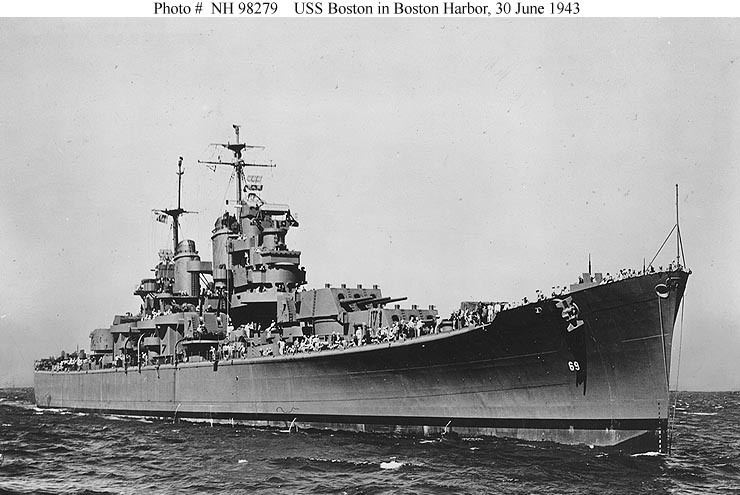 | ||
Sponsored by Mrs. Helen Noonan Tobin | ||
USS Boston (CA-69/CAG-1), a Baltimore-class heavy cruiser, was the sixth ship of the United States Navy to be named for the U.S. city of Boston, Massachusetts. Boston was launched 26 August 1942 by Bethlehem Steel Company's, Fore River Shipyard in Quincy, Massachusetts; sponsored by Mrs. Helen Noonan Tobin, wife of the Mayor of Boston, Maurice J. Tobin; and commissioned 30 June 1943, Captain J. H. Carson in command.
Contents
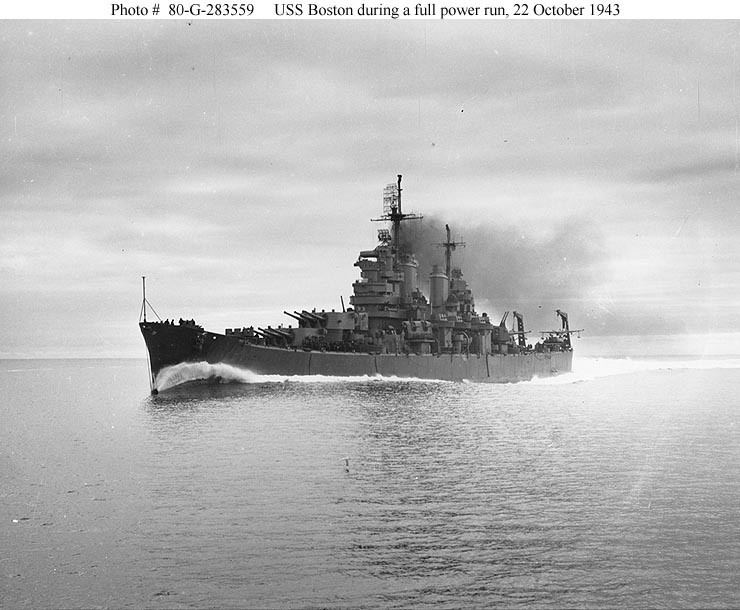
World War II
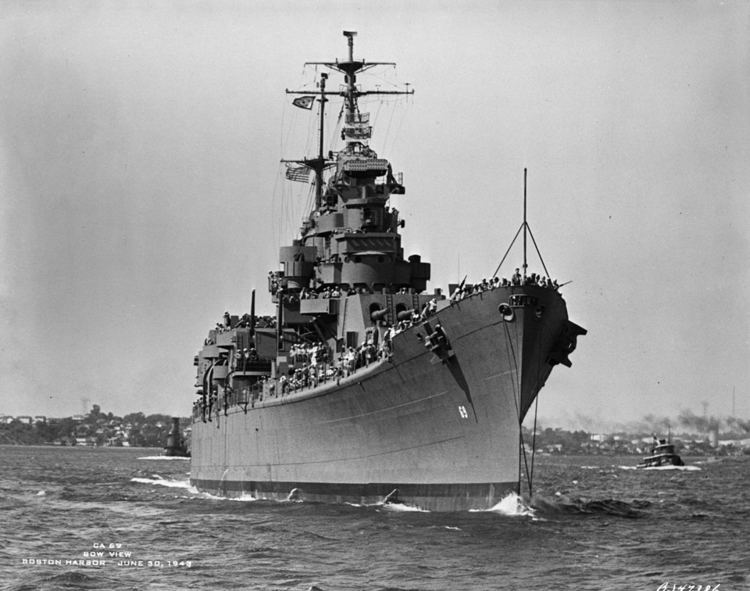
Boston reported to the Pacific Fleet, arriving at Pearl Harbor 6 December 1943. She joined Task Force 58 (TF 58) in January and took part in the raids on the Marshall Islands in support of the invasions of Kwajalein, Majuro, and of Eniwetok (31 January – 28 February 1944).

Boston also supported the assaults on the Palaus and Western Carolines between 30 March and 1 April, and operations at Hollandia (currently known as Jayapura) and Western New Guinea on 21 – 24 April. The ship participated in the attack on Truk, including bombardment of Satawan Island between 29 April – 1 May. Boston supported the invasion of Saipan between 11 and 24 June. She also took part in several raids on the Bonin Islands in June and July and supported the carrier task forces during the Battle of the Philippine Sea on 19 June. Boston towed the crippled Houston after it was torpedoed by the Japanese.
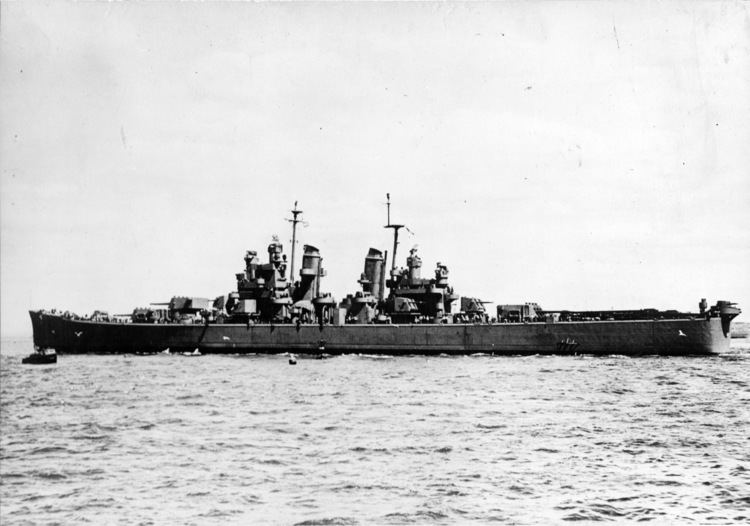
Boston returned to the Marianas, to support the invasion of Guam on 12 July, until the successful completion of the campaign on 15 August. She also took part in the raids on Palau-Yap-Ulithi between 25 and 27 July, as well as the landings on Morotai on 15 September, and the seizure of the southern Palaus between 6 September – 14 October. She also supported the raids on the Philippine Islands, starting on 9 September until 24 September.
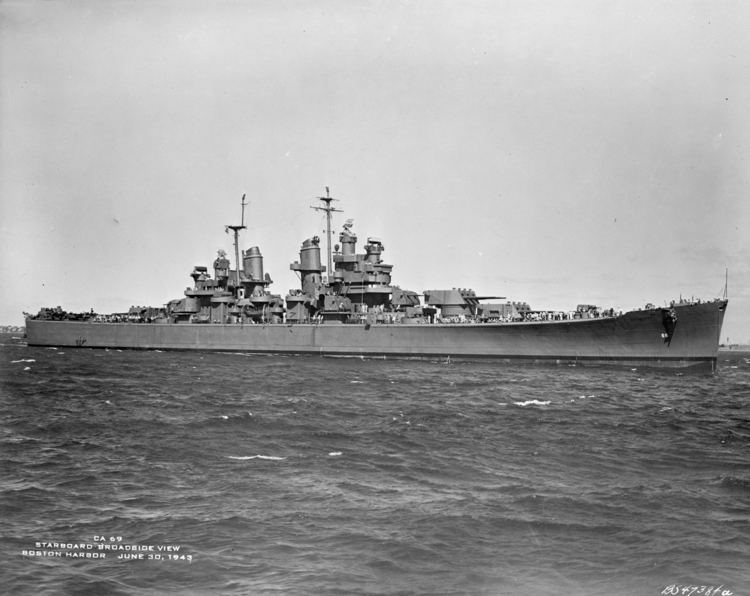
She served with TF 38 during the Okinawa raid on 10 October, and the northern Luzon and Formosa raid on 11–14 October, as well as the Luzon raids on 15 October and 24–26 October, 13–14 November and 19–20 November, and 14–16 December. Boston also participated in the Battle of Leyte Gulf on 24 October, as well as the Formosa raids in January, on 3–4, 9, 15, and 21 January 1945. Further raids on Luzon took place on 6–7 January, with raids on the Chinese mainland on 12 and 16 January. The carrier task force launched a raid on Nansei Shoto on 22 January, and Honshū and Nansei Shoto raids on 15–16 February and 1 March, in which she bombarded Japan itself.
Boston then returned to the United States for overhaul, arriving at Long Beach, California, 25 March 1945. Returning to the Western Pacific, via Pearl Harbor and Eniwetok, she joined TF 38 for the raids on the Japanese home islands (20 July – 15 August), including the bombardment of Kamaishi, Honshū (9 August). Following the Japanese surrender, Boston remained in the Far East on occupation duty until 28 February 1946. She then returned to the United States and was placed out of commission in reserve at Puget Sound Naval Shipyard on 12 March 1946.
Recommissioned as guided missile cruiser
Boston (along with Canberra and Chicago) was not recommissioned for service during the Korean War as were 10 others of her sister ships, but was earmarked for conversion to carry guided missiles and was reclassified CAG-1 on 4 January 1952. In February 1952 she was towed from Bremerton, Washington, to Philadelphia for conversion to a guided missile heavy cruiser by New York Shipbuilding Corporation, Camden, New Jersey. During conversion her aft 8 inch turret was replaced with anti-aircraft missile launchers and she was otherwise modernized. Boston was recommissioned 1 November 1955 as the lead ship of her class and operated along the east coast and in the Caribbean conducting missile evaluations and participating in fleet exercises until departing for the Mediterranean 23 November 1956. She returned in May 1957.
After making a Midshipmen's cruise to South America, taking part in NATO exercises in the North Atlantic, and receiving an overhaul, Boston made her second Sixth Fleet tour during June–September 1958. This cruise included participation in the Lebanon crisis. During the next eight years she frequently operated in the Mediterranean, often in the role of flagship, as well as taking part in exercises off Northern Europe, in the Caribbean and off the U.S. East Coast. Boston served as flagship for the recovery effort of the Palomares Incident from February through April 1966.
Vietnam War
In April 1967, Boston returned to the Pacific for the first time in fifteen years, transiting the Panama Canal to begin a tour of combat service with the 7th Fleet. Part of Naval Gunfire Support Task Unit 77.8.9 and Sea Dragon operations off North Vietnam, she fired thousands of rounds of eight and five-inch shells against targets in North and South Vietnam. Though continuing to be based on the East Coast, the cruiser made two more deployments to the Western Pacific, in April–October 1968 and May–November 1969, the only 6th Fleet cruiser to make 3 tours to the combat zone. In May 1968, Boston was reclassified from "Guided-Missile Heavy Cruiser" to "Heavy Cruiser, Attack", reverting to her original hull number, CA-69. Though she retained her Terrier missiles, the swift advance of technology had made these weapons obsolete after little more than a dozen years' service, and her main battery was once again her eight-inch rifles, of which six remained in her forward turrets. On 16–17 June 1968, while conducting naval gunfire against North Vietnamese targets, in company with Australian guided missile destroyer Hobart, Boston was accidentally attacked by USAF jet aircraft from the 366th TFW. Two Australian sailors were killed, and minor damage occurred to both warships. The ships were in the vicinity of Swift Boats PCF-12 & 19, which had come under attack by North Vietnamese helicopters. PCF-19 was sunk with 5 KIA. F-4 Phantom IIs from Da Nang Air Base responded and arrived on scene after the North Vietnamese helicopters departed. The US Navy currently maintains the Swift Boat attack as part of Boston and Hobart incident, and officially records the incident as friendly fire.
Decommissioning
While on her last Vietnam cruise some thought and funding was given to overhaul Boston (and sister ship Canberra) for further service. Her Terrier missile system would have been upgraded to Standard Missile-ER with new radars and equipment needed to operate the modern missiles. Her gunnery systems would also have been refurbished. In addition, her hull and electronics would have been overhauled as well, giving the ship another 10 years of life. With the decline in defence spending, funds for this work were reallocated to newer ships and Boston sailed for her namesake city in late 1969 for a last visit and open house prior to her decommissioning. While Senator Edward Kennedy express views that the ship should be retained as a museum on the cities waterfront, no plans were proposed and Boston began the inactivation process soon after finishing her final Vietnam cruise. Decommissioned at the Boston Navy Yard's South Boston Naval Annex in South Boston, Massachusetts, on 5 May 1970, she was stricken from the Naval Vessel Register in January 1973 (one source says 1974) and sold for scrapping in March 1975. Scrapping was completed in 1976.
Awards
Boston received 10 battle stars for her World War II service and 5 more during the Vietnam War. She also received the Navy Unit Commendation for her naval gunfire support during the Battle of Đông Hà, May 1968. Boston was also honored with the Republic of Vietnam Meritorious Unit Citation- Gallantry for naval gunfire support and "Sea Dragon" Operations during the period 30 July – 30 August 1968 and again during Operation Brave Armada and Operation Durham Peak in June–July 1969.
